Nerites are snails with thick and somewhat hemispherical shells, making them difficult for predators to grip and crack. They have a semi-circular aperture (i.e. the doorway) that for some species may come with a few teeth on the inner side, and a tight-fitting operculum (i.e. the trapdoor) with a peg that can "lock" the operculum within the aperture. The spire usually appears somewhat depressed.
Nerites generally feed on algae, and they are usually found along the shore, either on rocks, tree trunks, or among other snails on sandy shores or in tidal streams. Some species are collected for shellcraft, and the bigger species are collected for food.
Here are the nerites that I have photographed on our shores so far (thanks to Siong Kiat who gave tips on how to identify them!). You may want to take a look at my diagram on the parts of a snail's shell if you are not familiar with the names of the parts, so as to better understand the terms used below.

The Articulate Nerite (Nerita articulata) is very abundant in our mangroves and adjacent rocky shores. Often, many are seen clustering on tree trunks. The size can get to about 3cm across.

The shell is marked with black spiral cords, with pale-coloured gaps between the cords. The spire is very short.
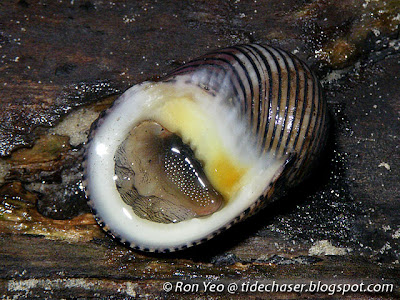
On the underside, there are usually yellow stains on the inner lip, with a few medium sized teeth. The foot of the animal has black stripes.
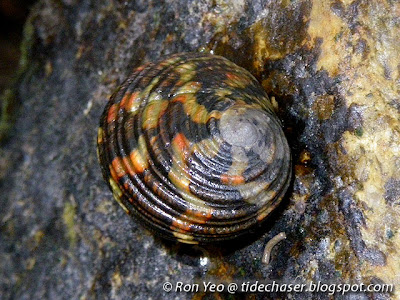
The Chameleon Nerite (Nerita chamaeleon) is another very common nerite, usually occuring on rocky shores or sandy areas with small loose stones. It has very variable colour and patterns with a very short spire. The thick spiral cords are generally smooth when you run your finger along the cords.
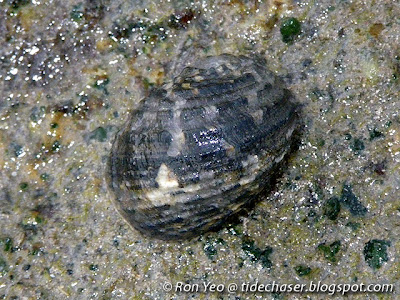
Here's a very well-eroded shell with darker colours. This species can get to about 2cm acoss, and has a short spire.

On the underside, it has a few small teeth on the inner lip. The columella is often marked with a few small bumps and ridges.
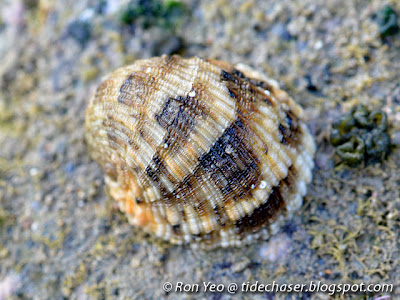
The Scaled Nerite (Nerita histrio) is found on rocky shores. The shell is marked with crowded rows of scales running over the spiral cords. Hence, if you run your finger along the spiral cords, it will feel very rough.

The colour is rather variable, and hence well eroded specimens may be mistaken for the previous species. It is about 2cm in size. The spire is very short, and often appear flattened.

On the underside, it has a few smooth teeth on the inner lip, sometimes marked with a patch of orange stains extending to the columella. The columella usually lacks the obvious bumps and ridges seen in the previous species.
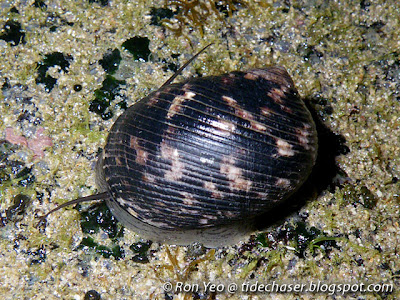
The Undate Nerite (Nerita undata), also known as the Waved Nerite ("undate" means "wave-like, or undulate"), is very commonly seen on rocky areas. It has a short spire.
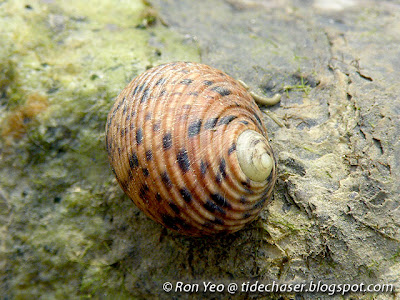
The colours and patterns are also rather variable. The shell is marked with numerous smoothish spiral cords. It grows to about 3cm across.

On the underside, it can be easily distinguished by the big teeth on the inner lip. Often, there are yellow stains at the corners of the aperture.

The Gray's Nerite (Nerita grayana) is sometimes regarded as a synonym of the previous species. However, many scientist disagree due to several obvious differences. The spire is shorter, but usually appear slightly higher and more pointed than the previous species.

The underside is usually marked by a slight orange stain, but more importantly, the teeth on the inner lip is smaller than those of the previous species and each teeth has a narrow cut in the middle. It gets to about 3cm across, and is found on rocky areas near mangrove or in the mangrove forest, but generally in more sheltered areas.

The Ox-palate Nerite (Nerita albicilla) is found on rocks near muddy areas. It appears more elongate than most other species, with a flattened spire, and the colour is usually a dull grey or greyish brown. It lacks the obvious thick spiral cords found in the other species mentioned above. The columella is broad and covered with numerous little bumps, while the teeth on the inner lip is small. It grows to about 3cm long.

The Flat-spired Nerite (Nerita planospira) is sometimes found on rocks near mangroves or on the roots of mangrove trees. It has thick and rough spiral cords, and a flattened spire.

The underside is marked with a black margin on the edge of the shell, and there is usually a black patch on the posterior end of the underside. The teeth on the inner lip are of medium size. It grows to about 3cm across.

The Polished Nerite (Nerita litterata) has very smooth shells with variable colours and patterns. It is usually found on rocky shores, especially the ones near coral reefs. The spire is very short, and often appear flattened. It was previously recorded as Nerita polita.

Here is another Polished Nerite with different colours and patterns. The attractive shells are often collected for shellcraft. It can grow to about 3cm across.

On the underside, the inner lip is usually smooth and if there are teeth present on the inner lip, they are usually small and not obvious.

The Oualan Nerite (Clithon oualaniensis) has a very smooth shell with very variable in shell patterns, ranging from lines to spots to triangular shapes. The base colour is usually cream or white. The columella is smooth, and there are a few small teeth on the inner lip. They are usually found in large numbers on sandy substrates, usually among seagrass or in more sheltered parts of a shore. This species is often collected for its beautiful shell. It can grow to about 1cm across, but is usually less than half of that.

The Siquijor Nerite (Neritina siquijorensis) is usually found in tidal streams in mangroves, sometimes among seagrass patches. It is usually greenish brown in colour, with black scale-like markings. The shell is usually rather smooth. It grows to about 1cm long, but is usually much smaller.
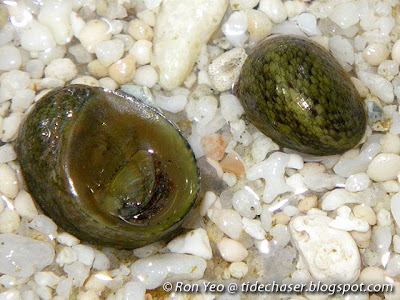
The inner lip is marked with a few small teeth, and the columella is quite smooth.

The Black-mouthed Nerite (Dostia cornucopia) is usually found in mangrove forests. The shell is black, or marked with blotchy, dark patterns on a brown background.

The underside is dark brown, with an orange or bright brown border. It can grow to about 1cm long.

The Red-mouthed Nerite (Dostia violacea) is also found in mangrove forests. The shell is very similar to the previous species, usually with black patches or bands on a dark brown background.

The underside, however, is orange to reddish. It can grow to about 1cm long.
References
Nerites generally feed on algae, and they are usually found along the shore, either on rocks, tree trunks, or among other snails on sandy shores or in tidal streams. Some species are collected for shellcraft, and the bigger species are collected for food.
Here are the nerites that I have photographed on our shores so far (thanks to Siong Kiat who gave tips on how to identify them!). You may want to take a look at my diagram on the parts of a snail's shell if you are not familiar with the names of the parts, so as to better understand the terms used below.

The Articulate Nerite (Nerita articulata) is very abundant in our mangroves and adjacent rocky shores. Often, many are seen clustering on tree trunks. The size can get to about 3cm across.

The shell is marked with black spiral cords, with pale-coloured gaps between the cords. The spire is very short.

On the underside, there are usually yellow stains on the inner lip, with a few medium sized teeth. The foot of the animal has black stripes.

The Chameleon Nerite (Nerita chamaeleon) is another very common nerite, usually occuring on rocky shores or sandy areas with small loose stones. It has very variable colour and patterns with a very short spire. The thick spiral cords are generally smooth when you run your finger along the cords.

Here's a very well-eroded shell with darker colours. This species can get to about 2cm acoss, and has a short spire.

On the underside, it has a few small teeth on the inner lip. The columella is often marked with a few small bumps and ridges.

The Scaled Nerite (Nerita histrio) is found on rocky shores. The shell is marked with crowded rows of scales running over the spiral cords. Hence, if you run your finger along the spiral cords, it will feel very rough.

The colour is rather variable, and hence well eroded specimens may be mistaken for the previous species. It is about 2cm in size. The spire is very short, and often appear flattened.

On the underside, it has a few smooth teeth on the inner lip, sometimes marked with a patch of orange stains extending to the columella. The columella usually lacks the obvious bumps and ridges seen in the previous species.

The Undate Nerite (Nerita undata), also known as the Waved Nerite ("undate" means "wave-like, or undulate"), is very commonly seen on rocky areas. It has a short spire.

The colours and patterns are also rather variable. The shell is marked with numerous smoothish spiral cords. It grows to about 3cm across.

On the underside, it can be easily distinguished by the big teeth on the inner lip. Often, there are yellow stains at the corners of the aperture.

The Gray's Nerite (Nerita grayana) is sometimes regarded as a synonym of the previous species. However, many scientist disagree due to several obvious differences. The spire is shorter, but usually appear slightly higher and more pointed than the previous species.

The underside is usually marked by a slight orange stain, but more importantly, the teeth on the inner lip is smaller than those of the previous species and each teeth has a narrow cut in the middle. It gets to about 3cm across, and is found on rocky areas near mangrove or in the mangrove forest, but generally in more sheltered areas.

The Ox-palate Nerite (Nerita albicilla) is found on rocks near muddy areas. It appears more elongate than most other species, with a flattened spire, and the colour is usually a dull grey or greyish brown. It lacks the obvious thick spiral cords found in the other species mentioned above. The columella is broad and covered with numerous little bumps, while the teeth on the inner lip is small. It grows to about 3cm long.

The Flat-spired Nerite (Nerita planospira) is sometimes found on rocks near mangroves or on the roots of mangrove trees. It has thick and rough spiral cords, and a flattened spire.

The underside is marked with a black margin on the edge of the shell, and there is usually a black patch on the posterior end of the underside. The teeth on the inner lip are of medium size. It grows to about 3cm across.

The Polished Nerite (Nerita litterata) has very smooth shells with variable colours and patterns. It is usually found on rocky shores, especially the ones near coral reefs. The spire is very short, and often appear flattened. It was previously recorded as Nerita polita.

Here is another Polished Nerite with different colours and patterns. The attractive shells are often collected for shellcraft. It can grow to about 3cm across.

On the underside, the inner lip is usually smooth and if there are teeth present on the inner lip, they are usually small and not obvious.

The Oualan Nerite (Clithon oualaniensis) has a very smooth shell with very variable in shell patterns, ranging from lines to spots to triangular shapes. The base colour is usually cream or white. The columella is smooth, and there are a few small teeth on the inner lip. They are usually found in large numbers on sandy substrates, usually among seagrass or in more sheltered parts of a shore. This species is often collected for its beautiful shell. It can grow to about 1cm across, but is usually less than half of that.

The Siquijor Nerite (Neritina siquijorensis) is usually found in tidal streams in mangroves, sometimes among seagrass patches. It is usually greenish brown in colour, with black scale-like markings. The shell is usually rather smooth. It grows to about 1cm long, but is usually much smaller.

The inner lip is marked with a few small teeth, and the columella is quite smooth.

The Black-mouthed Nerite (Dostia cornucopia) is usually found in mangrove forests. The shell is black, or marked with blotchy, dark patterns on a brown background.

The underside is dark brown, with an orange or bright brown border. It can grow to about 1cm long.

The Red-mouthed Nerite (Dostia violacea) is also found in mangrove forests. The shell is very similar to the previous species, usually with black patches or bands on a dark brown background.

The underside, however, is orange to reddish. It can grow to about 1cm long.
References
- Abbott, R. T., 1991. Seashells of Southeast Asia. Graham Brash, Singapore. 145 pp.
- Carpenter, K. E. & V. H. Niem (eds), 1998-2001. FAO species identification guide for fishery purposes. The living marine resources of the Western Central Pacific. Volumes 1 to 6. FAO, Rome. pp. 1-4218.
- Gladys Archerd Shell Collection at Washington State University Tri-Cities Natural History Museum. 2008. Retrieved September 26, 2012, from http://shells.tricity.wsu.edu/ArcherdShellCollection/ShellCollection.html.
- Oliver, A. P. H., 2012. Philip's guide to seashells of the world. Philip's, London. 320 pp.
- Tan, K. S. & L. M. Chou, 2000. A guide to common seashells of Singapore. Singapore Science Centre, Singapore. 168 pp.
- Tan, S. K. & H. P. M. Woo, 2010. A preliminary checklist of the molluscs of Singapore. Raffles Museum of Biodiversity Research, National University of Singapore, Singapore. 78 pp. Uploaded 02 June 2010.
- Tan, S. K. & R. K. H. Yeo, 2010. The intertidal molluscs of Pulau Semakau: preliminary results of “Project Semakau”. Nature in Singapore, 3: 287–296.
- World Register of Marine Species. 2012. Retrieved Oct 22, 2012, from http://www.marinespecies.org.

No comments:
Post a Comment